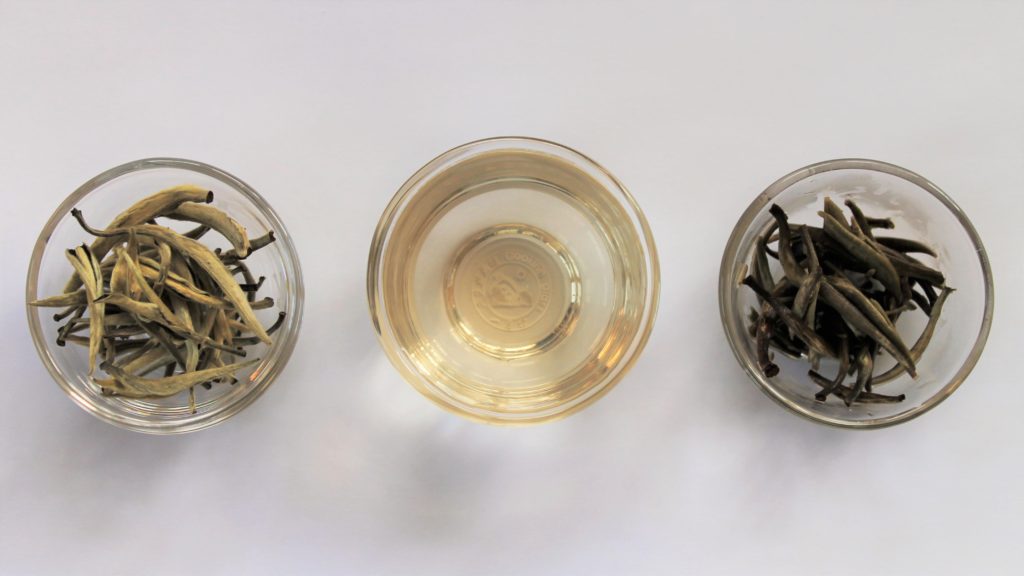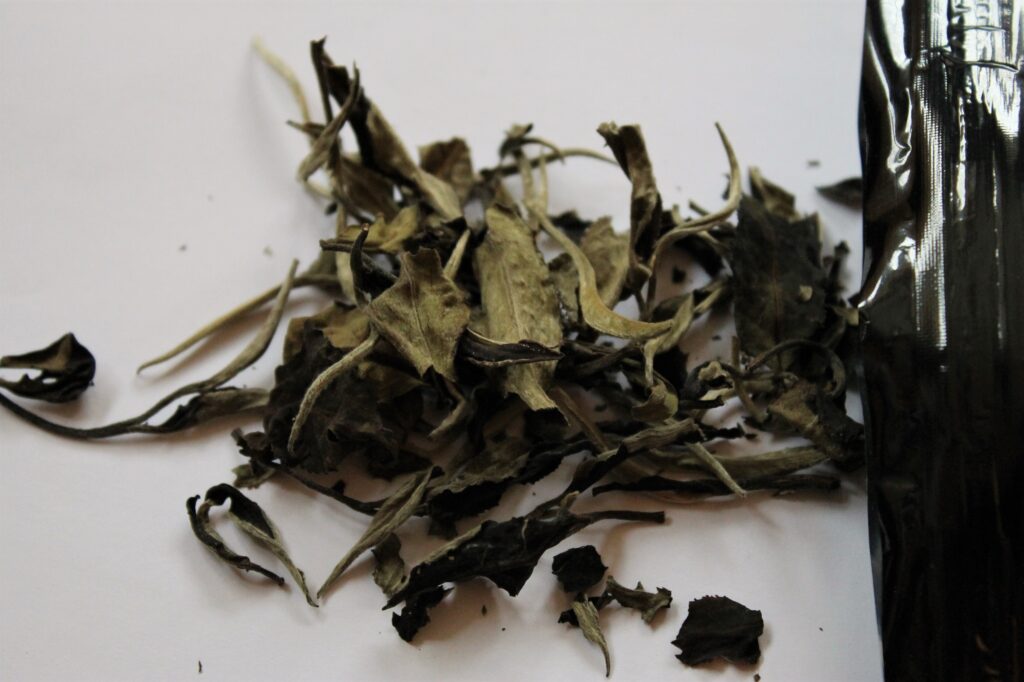White tea types are some of my favourite teas to sip. Their melon and stone fruit sweetness and delicate grassiness just can’t be beaten. So, I’m always on a mission to help other tea drinkers (new and experienced) discover just how good white tea is.
Yes, finding good quality white tea means venturing further than the supermarket or even speciality high street tea sellers. But trust me, it is so worth it.
In this guide to white tea types, you will learn about the history of white tea, how it is processed, and the best white tea types to drink. If you are completely new to tea, I recommend trying a tea exploration box like the Teapro Subscription White Tea Box.
White Tea 101
White tea is one tea type, just like green tea or black tea, or even oolong tea or pu-erh. All of these teas are made from the same plant – Camellia sinensis. What makes the leaves turn into white tea or any other tea type is all about how they are processed.
White tea is the least processed (more on this below) and typically has light, sweet and fresh notes. Like green tea, white tea is floral and sweet but replaces much of the grassiness with nectar, honey and stone fruits instead.
All tea made from the Camellia sinensis tea plant is caffeinated, unless it has been purposefully decaffeinated – learn more about the difference in my article Decaffeinated vs Caffeine Free Tea.
History of White Tea
The origins of white tea are not overly clear. Like most tea types, the origin was likely China and in one of the tea-producing regions, like Fujian. This is where most white tea is grown today.
As for how old white tea is, it could be a few hundred years. Tea drinking practices go back many centuries and span the entire world – many civilisations steeped plant material in water for medicinal purposes, with China using the Camellia sinensis plant first simply because it is native to that area of the world.
White Tea Processing
To make white tea, the following process is observed:
- In the springtime, farmers wait for the young buds of the tea plant to emerge.
- The buds and first young leaves of the tea plant are plucked (by hand or machine).
- These buds and leaves are quickly dried either in the sun or possibly by steaming or firing them.
- Once fully dried, they are packaged and ready to be shipped away.
The key to white tea is to process it as little as possible. It should be picked and then dried. Green tea, on the other hand, is fixed quickly to keep the leaves from oxidising – the leaves may also be picked later in the season. Black tea is heavily processed. In fact, the leaves are bashed and crushed somewhat to encourage oxygen to reach them. This turns the leaves dark and produces that malty tannin flavour.
For tea bags, white tea may be cut or torn into smaller pieces. Alternatively, white tea bags may be filled with leftover broken leaves and twigs from the process of making a loose leaf white tea. In general, whole loose leaf teas are a much better quality than teabags.

White Tea Types (AKA Grades)
There are three specific ‘types’ of white tea: silver needle, white peony, and longevity eyebrow. If you are buying loose leaf, it is often very easy to see what kind of white tea you have purchased. For example, this Sri Lankan White Tea by Teakruthi is clearly white peony as it contains the first bud of the tea plant as well as the first leaves.
Let’s dive into more detail.
Silver Needle (Baihao Yinzhen)
Silver needle, or baihao yinzhen, is made from the furry white buds of the tea plant and nothing else. That’s why this tea looks like soft silver needles rather than tea leaves! This is the most expensive white tea, but also the best. It produces a delicate and delicious cuppa that’s the furthest away from the flavour profile of green tea.
Typically, silver needle tea has notes of melon and orchid. It’s light, fragrant and sweet. My favourite pure silver needle tea is this loose leaf silver needle by Teapro. It is a perfect example of what a silver needle white tea should look and taste like, so you can use it to compare it with other silver needles from other tea companies.
White Peony (Bai Mudan)
White peony, or bai mudan, is the next white tea type. Made from the buds and the first leaf of the tea plant, it has a good ratio of leaf to bud. Like silver needle, you can easily identify white peony loose leaf by looking for those buds and leaves. The inclusion of the first leaves doesn’t just make it cheaper to purchase, it also changes the flavour and aroma profile.
Typically, white peony has sweet, earthy, and floral notes. The melon notes drop away, with some stone fruit hints replacing them. That orchid aroma tends to linger, however, and there’s also more richness like sweet honey. My favourite white peony is a 2018 Spring Mountain White Tea from Crafted Leaf.
Longevity Eyebrow (Shou Mei)
The final white tea type is longevity eyebrow, or shou mei. Although it’s the ‘lowest’ grade, it is still delicious. Made from the sun-withered upper leaves and tips of the tea plant, it looks similar to white peony but is typically darker in colour while white peony leaves are greener. I have struggled to find many loose leaf longevity eyebrow teas, but I suspect that many teabag white teas are secretly using this white tea type.
Clipper White Tea Bags are a good example. Dark-coloured leaves, finely chopped for convenient tea bag brewing. Typical flavour notes for any shou mei are vanilla sweetness, orchid floral tones, and earth. You’ll also find woody and nutty notes – if you enjoy mid-oxidised oolong teas, then shou mei will be perfect for you.
Cakes and Pearls
Like other tea types, white tea can be formed into different shapes. They can be pressed into cakes, like pu-erh tea, or rolled into balls/pellets. Green tea dragon pearls are very common, but they can also be made with white tea. A wonderful example (and one of my all-time favourite teas) is Teapro Jasmine Dragon Pearl White Tea. This tea is made by hand-rolling a jasmine petal and white tea leaf together. They are wonderful to watch unfurl too!

White Tea Origin – Growing Regions
As white tea can be made with any tea leaves, you could make white tea anywhere in the world so long as the Camellia sinensis tea plant will grow there… technically. But of course, some tea cultivars and growing regions lend themselves better to white tea than others.
The original and biggest region for producing white tea is the Fujian province of China. This is where your Chinese silver needle, white peony and longevity eyebrow teas will be from. If you are purchasing fine loose leaf tea, you may have a specific region within Fujian listed as the origins too.
But other areas of the world are also experimenting with white tea.
- Sri Lanka – several Ceylon teas are available, including many from Teakruthi (like their Ceylon Gold tea, produced in Nuwara Eliya).
- India – I have tried a few Darjeeling white teas that were superb. The delicate tea produced in this region naturally lends itself to white tea.
- Taiwan – along with the occasional white tea, you’ll find some magnificent oolongs produced here.
- Thailand, Nepal and areas of India – you can find white tea produced by some estates here too.
If you are looking for white tea produced from single estates, then it is worth checking speciality tea traders too. For example, What-Cha currently has a Kenyan silver needle white tea and I found a Nepalese white tea in Hebden Tea’s online store. Stock tends to change quickly in speciality tea stores, so don’t be surprised if there’s an entirely different lineup of teas the next time you check.
FAQs
White tea is a type of tea made from the Camellia sinensis tea plant. The leaves of this plant can be made into black tea, green tea, or any other tea type. To make white tea, the leaves are picked and quickly dried to preserve them. This minimal processing technique results in fresh, sweet and crisp flavours.
White tea comes from the Camellia sinensis tea plant. Most white tea comes from China, however, other tea-growing countries also produce speciality white teas, such as Sri Lanka, Nepal, Taiwan, India and Thailand.
White tea is made from the young buds and first new leaves of the Camellia sinensis tea plant. It is how these tea buds and leaves are processed that makes white tea different to green tea, black tea, and other tea types.
White tea is made by plucking the buds and/or new leaves of the tea plant, and quickly fixing them to prevent oxidation. When the leaves are exposed to oxygen, they oxygenate into black tea! So, in layman’s terms, white tea is simply leaves and buds that are picked and dried with no additional processing.
